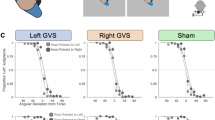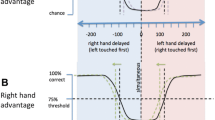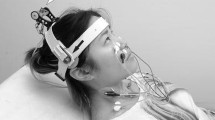Abstract
Seventeen normal subjects were asked to direct a laser point to the position they felt to lie exactly straight ahead of their body. Subjects were seated in complete darkness in an approximately spherical cabin in an upright position with the orientation of the trunk and head aligned. For both the horizontal and vertical plane, “straight ahead” judgements were closely scattered around the objective straight ahead body position. Posterior neck muscle vibration as well as caloric vestibular stimulation with ice water led to (1) an apparent motion and horizontal displacement of a stationary visual target to the side opposite to stimulation and (2) a horizontal deviation of subjective “straight ahead” perception toward the side of stimulation. Only those subjects who experienced an illusion of target motion also showed a deviation of their subjective body orientation. No systematic effect of a displacement of subjective body orientation in the vertical plane was detected. When vestibular stimulation and neck muscle vibration were combined their effects were additive, i.e. the horizontal deviation of subjective body orientation observed when either type of stimulation was applied in isolation, was linearly combined either by summation or by cancellation. The present results clearly support the assumption that afferent visual, vestibular and proprioceptive input converge to the neural generation of an egocentric, body-centred coordinate system that allows us to determine our body position with respect to visual space.
Similar content being viewed by others

References
Andersen RA, Snyder LH, Li C-S, Stricanne B (1993) Coordinate transformations in the representation of spatial information. Curr Opin Neurobiol 3:171–176
Biguer B, Donaldson IML, Hein A, Jeannerod M (1988) Neck muscle vibration modifies the representation of visual motion and direction in man. Brain 111:1405–1424
Blanks RHI, Curthoys IS, Markham CH (1975) Planar relationships of the semicircular canals in man. Acta Otolaryngol 80:185–196
Boehmer A, Straumann D, Kawachi N, Arai Y, Henn V (1992) Three-dimensional analysis of caloric nystagmus in the Rhesus monkey. Acta Otolaryngol 112:916–926
Brecher GA, Brecher MH, Kommerell G, Sauter FA, Sellerbeck J (1972) Relation of optical and labyrinthean orientation. Opt Acta 19:467–471
Brodal A, Pompeiano O (1957) The vestibular nuclei in the cat. J Anat 91:438–454
De Jong PTVM, De Jong JMBV, Cohen B, Jongkees LBW (1977) Ataxia and nystagmus induced by injection of local anesthetics in the neck. Ann Neurol 1:240–246
Dichgans J, Brandt T (1978) Visual-vestibular interaction: effects on self-motion perception and postural control. In: Held R, Leibowitz HW, Teuber H-L (eds) Handbook of sensory physiology, vol VIII. Perception. Springer, Berlin Heidelberg New York, pp 755–804
Eklund G (1972) General features of vibration-induced effects on balance. Ups J Med Sci 77:112–124
Eklund G (1973) Further studies of vibration-induced effects on balance. Ups J Med Sci 78:65–72
Fischer MH, Kornmüller AE (1931) Egozentrische Lokalisation. 2. Mitteilung (optische Richtungslosigkeit beim vestiäularen Nystagmus). J Psychol Neurol (Lpz) 41:383–420
Fredrickson JM, Schwarz D, Kornhuber HH (1966) Convergence and interaction of vestibular and deep somatic afferents upon neurons in the vestibular nuclei of the cat. Acta Otolaryngol 61:168–188
Goodwin GM, McCloskey DI, Matthews PBC (1972) The contribution of muscle afferents to kinaesthesia shown by vibration induced illusions of movement and by the effects of paralysing joint afferents. Brain 95:705–748
Graybiel A, Hupp DI (1946) The oculo-gyral illusion, a form of apparent motion which may be observed following stimulation of the semicircular canals. J Aviat Med 17:3–27
Hamann KF, Strauss K, Kellner M, Weiss U (1992) Dependence of visual straight ahead on vestibular influences. In: Krejcova H, Jerabek J (eds) Proceedings of XVIIth Bárány Society Meeting, Castle Dobříš, Czechoslovakia, pp 65–66
Holst E von, Mittelstaedt H (1950) Das Reafferenzprinzip (Wechselwirkungen zwischen Zentralnervensystem und Peripherie). Naturwissenschaften 37:464–475
Karnath HO, Schenkel P, Fischer B (1991) Trunk orientation as the determining factor of the ‘contralateral’ deficit in the neglect syndrome and as the physical anchor of the internal representation of body orientation in space. Brain 114:1997–2014
Karnath HO, Christ K, Hartje W (1993) Decrease of contralateral neglect by neck muscle vibration and spatial orientation of trunk midline. Brain 116:383–396
Lackner JR, Levine MS (1979) Changes in apparent body orientation and sensory localization induced by vibration of postural muscles: vibratory myesthetic illusions. Activation Space Environ Med 50:346–354
Matthews PBC (1966) The reflex excitation of the soleus muscle of the decerebrate cat caused by vibration applied to its tendon. J Physiol (Lond) 184:450–472
Mergner T, Nardi GL, Becker W, Deecke L (1983) The role of canal-neck interaction for the perception of horizontal trunk and head rotation. Exp Brain Res 49:198–208
Mergner T, Siebold C, Schweigart G, Becker W (1991) Human perception of horizontal trunk and head rotation in space during vestibular and neck stimulation. Exp Brain Res 85:389–404
Mergner T, Rottler G, Kimmig H, Becker W (1992) Role of vestibular and neck inputs for the perception of object motion in space. Exp Brain Res 89:655–668
Morant RB (1959) The visual perception of median plane as influenced by labyrinthian stimulation. J Psychol 47:25–35
Mori S, Mikami A (1973) Excitation of Deiter's neurons by stimulation of the nerves to neck extensor muscles. Brain Res 56:331–334
Pompeiano O (1988) The tonic neck reflex: supraspinal control. In: Peterson BW, Richmond FJ (eds) Control of head movement. Oxford University Press, New York, pp 108–119
Prochazka A, Wand P (1980) Tendon organ discharge during voluntary movements in cats. J Physiol (Lond) 303:385–390
Pyykkö I, Aalto H, Seidel H, Starck J (1989) Hierarchy of different muscles in postural control. Acta Otolaryngol [Suppl 468]: 175–181
Roberts TDM (1973) Reflex balance. Nature 244:156–158
Roll JP, Roll R, Velay JL (1991) Proprioception as a link between body space and extra-personal space. In: Paillard J (ed) Brain and space. Oxford University Press, New York, pp 112–132
Taylor JL, McCloskey DI (1991) Illusions of head and visual target displacement induced by vibration of neck muscles. Brain 114:755–759
Ventre J, Flandrin JM, Jeannerod M (1984) In search for the egocentric reference. A neurophysiological hypothesis. Neuropsychologia 22:797–806
Wapner S, Werner H, Chandler KA (1951) Experiments on the sensory-tonic field theory of perception: I. Effect of extraneous stimulation on the visual perception of verticality. J Exp Psychol 42:351–357
Wilson VJ (1988) The tonic neck reflex: spinal circuitry. In: Peterson BW, Richmond FJ (eds) Control of head movement. Oxford University Press, New York, pp 100–107
Author information
Authors and Affiliations
Rights and permissions
About this article
Cite this article
Karnath, H.O., Sievering, D. & Fetter, M. The interactive contribution of neck muscle proprioception and vestibular stimulation to subjective “straight ahead” orientation in man. Exp Brain Res 101, 140–146 (1994). https://doi.org/10.1007/BF00243223
Received:
Accepted:
Issue Date:
DOI: https://doi.org/10.1007/BF00243223



